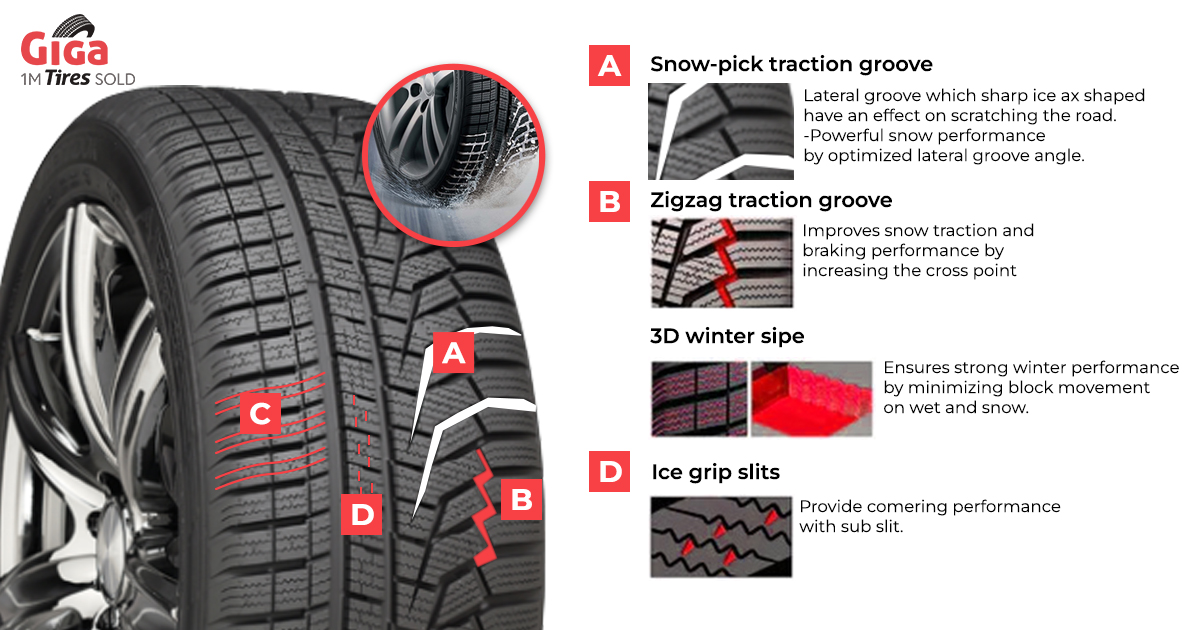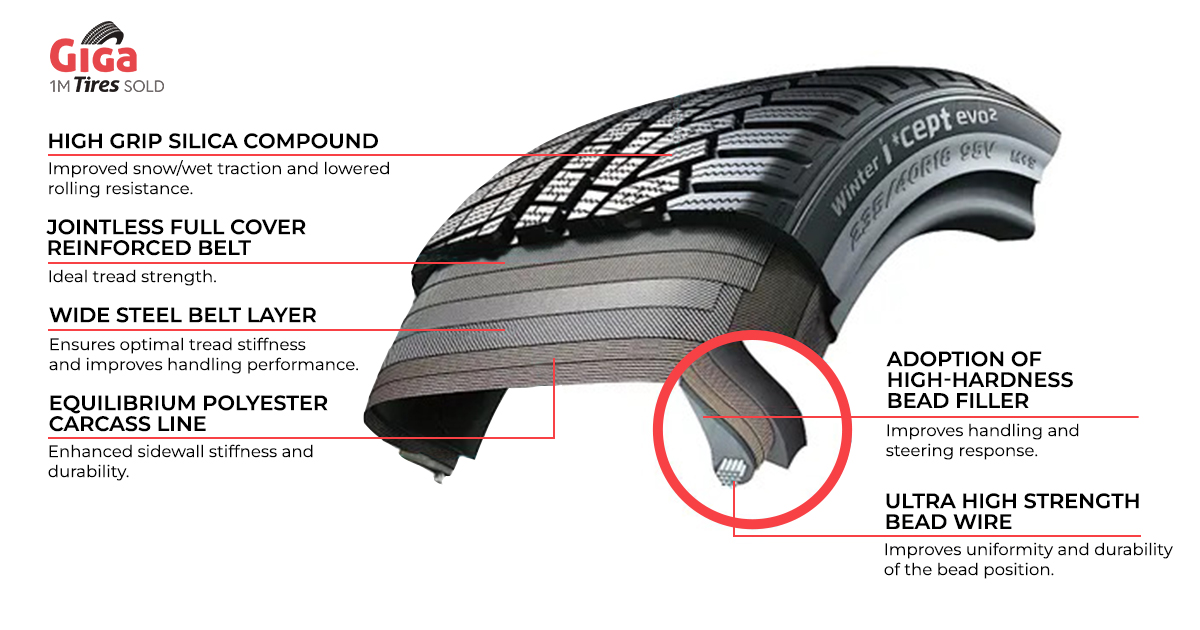Last Updated on 12 hours
Choosing the Right Winter Tires and Vehicle Technology
One of the biggest game-changers for the automotive industry was the introduction of electronic systems. Not only did these advancements replace the mechanical components, but they also significantly impacted safety, vehicular technology and engine management.
These advancements include but are not limited to, anti-lock brakes, stability control, e-differentials, brake assists, and so many other patents that have saved millions of motorists’ lives and prevented countless accidents. Since electronic systems evolve with each new generation of cars, we can expect they will continuously progress, which means winter tires will also evolve in response.
If we think of winter tires as hardware and electronic systems as software, let’s explore how the combination of the two can create the ultimate winter driving experience.
Understanding Winter Tires
When winter weather gets tough, the right winter tires can mean the difference between staying safe or losing control. That’s where winter tires step in. Winter tires are a class of automotive tires made of unique rubber compounds. They use particular technology and tread design to enhance grip and stability in low temperatures on snow and ice. They provide significantly better traction and braking capabilities. In fact, winter tires can reduce stopping distances by up to 30% compared to all-season tires on snow-covered roads. This is why even the most capable and advanced electronic systems depend on winter tires to maintain the grip and control (braking or steering) on icy roads.
Automotive Technologies Designed To Enhance Stability And Control
Anti-Lock Braking System (ABS)
It is almost unbelievable, but ABS brakes were introduced nearly 50 years ago. It revolutionized vehicle safety by preventing wheel lock-ups and allowing drivers to retain control even during hard braking. The system is controlled by a computer that calculates speed, load, and brake pressure to deliver the best possible results (in this case the shortest braking distance possible). The ABS is virtually irreplaceable in snow and ice, and it works together with other systems (electronic stability control or adaptive cruise control) to deliver the fastest response possible. Of course, if you mount a set of studded tires, it could negatively impact the ABS performance due to their unique contact patch, which alters how the system interprets braking inputs.
Traction Control (TCS)
The TCS (traction control system) prevents wheel slips when accelerating by reducing engine power and applying brakes if needed. Again, this system is controlled by a computer and usually involves “drive-by-wire” throttle linkage. When the TCS notices that the driving wheels lose grip and are spinning, its speed will be reduced automatically to regain traction. Winter tires are an essential component that helps gain traction in harsh conditions and keep the TCS input to a minimum. With a capable AWD or 4×4 drivetrain, a proper set of winter tires, and TCS, you have the best combination for navigating deep snow.
Electronic Stability Control Technology
Electronic Stability Control (ESC) is the unsung hero of modern safety, constantly monitoring a vehicle’s movement or trajectory and intervening to prevent oversteer or understeer in real time. All of the current car manufacturers have some form of electronic stability control on their vehicles, but the names differ from brand to brand. You are probably familiar with ESC, ESP, DSC, and so on, and they all function on the same basic principles.
The computer calculates the steering wheel’s position, the vehicle’s speed, angle, slip, and so on to detect unwanted movements and act by applying perfectly calculated brake pressure on single or all wheels if necessary. It is very effective, especially on slippery surfaces, and it can quickly iron out driver mistakes. Of course, it cannot bend the laws of physics or prevent a crash if the speed is too high for the circumstances. However, Electronic Stability Control benefits greatly from winter tires since they help maintain the grip and stability of the vehicle on the road.
All Wheel Drive (AWD) and 4×4 Systems
Although, AWD and 4×4 drivetrains are often mentioned in car commercials and brochures, few people know what they stand for or how their operation differs.
AWD automatically adjusts power based on wheel slippage by sending up to 50% of the power to the wheels or axle with the most traction. Most AWD systems operate in two-wheel drive mode under normal conditions.
The 4×4 systems requires manual engagement for extreme conditions, mainly used by dedicated off-road vehicles and heavy-duty pickups. Unlike AWD, which automatically engages, 4×4 systems require the driver to manually switch from two-wheel drive to four-wheel drive. This manual engagement provides more control in situations like deep snow or off-road driving by sending up to 100% of power to an axle with the most grip and a diff lock (an abbreviation for a lockable differential). Doing this allows the axles to turn at the same speed, making the vehicle capable of tackling even the most challenging terrains.
While these drivetrains excel in snow, they reach their fullest potential when combined with capable winter tires to deliver the maximum winter performance. This is because, despite the mechanical advantage of those drive trains, the contact patch between the ground and the vehicle must be winter rubber in order to have superior traction.
Autonomous Driving Systems
Autonomous driving systems can be a controversial topic in the modern car world. However, they proved to be a valuable addition by helping commuters stay alert on long drives and additional advancements followed. Autonomous driving technologies, like lane-keeping assistance, self-parking, and adaptive cruise rely on sensors and cameras to make driving decisions. Despite these advantages, in winter conditions, their effectiveness is limited without the traction provided by winter tires. When the system needs to make fast maneuvers, such as emergency braking or avoiding, it relies solely on the tires to perform. If the tires are incapable of performing and lack sufficient traction, you are potentially in trouble.
Hill Descent Control (HDC)
The HDC is one of those lesser-known systems but immensely valuable in real life. As the name suggests, the Hill Descent Control helps drivers descend steep slopes (driving downhill) while maintaining safe speed. Modern HDC systems are very precise and consider the angle of descent, the vehicle’s weight, and so on. They perform better than any human driver could using just throttle and brake pedals.
However, imagine you descending the slope covered in snow. Without the grip of winter tires, even the most advanced HDC systems can’t prevent dangerous slides or loss of control. On snow-covered or icy slopes, winter tires are a necessary asset to provide the traction needed for the HDC to function properly.
Torque Vectoring Systems
Torque vectoring is an advanced drivetrain technology that distributes power dynamically to individual wheels for improved handling and stability. Automotive engineers have long dreamed of being able to deliver different power to each wheel and immensely improve cornering speeds and handling. In electric vehicles, torque vectoring systems take advantage of the instant torque delivery of electric motors to enhance cornering, acceleration, and braking performance. Of course, winter tires are irreplicable if you want any of these advanced technologies to be efficient. Also, pay attention to the difference between EV tires and standard car tires.
Conclusion
Modern automotive technologies like ABS, TCS, ESC, and torque vectoring have revolutionized driving safety, but their true potential is unlocked only with the right ‘hardware’ – winter tires. Just as software needs reliable hardware to function, your car’s advanced systems rely on winter tires to conquer icy roads and ensure safety.
Investing in winter tires is a safety measure and a good way to maximize the benefits of your vehicle’s advanced technologies. Whether you drive a gas-powered car, hybrid, or EV, winter tires ensure you’re prepared for whatever winter throws your way. Combining winter tires with modern vehicle technologies creates the ultimate driving solution for safety and performance in even the harshest conditions.













